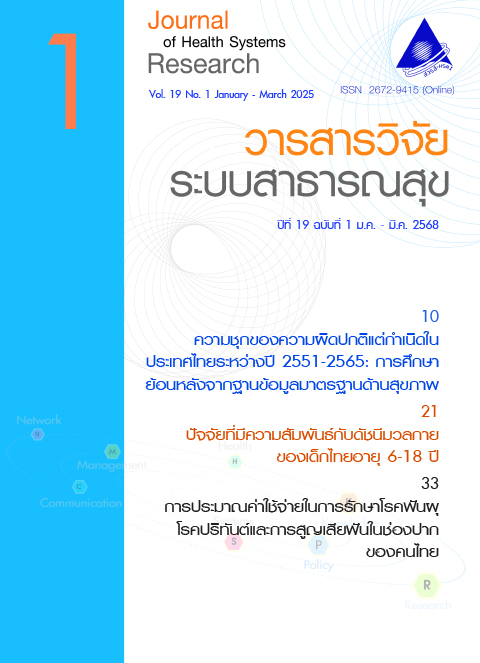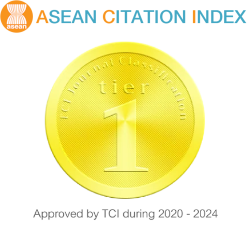Evaluation of the PM2.5 Surveillance System in Nakhon Phanom Province, Thailand: A Pilot Case Study
Keywords:
PM2.5, ICD-10, surveillance system, evaluation, Nakhon Phanom provinceAbstract
Thailand is facing air pollution problems from particulate matter of diameter less than 2.5 micron or PM2.5 exceeding standard levels every year. Particularly Nakhon Phanom province of Health Region 8 has been significantly affected. This study aimed to evaluate the PM2.5 surveillance system in Nakhon Phanom both qualitatively and quantitatively to develop policies and operational guidelines and to serve as a case study for Health Region 8. This research employed a mixed-method approach by conducting in-depth interviews with 11 public health officials and stakeholders and reviewing 508 medical records of patients suspected of PM2.5-related diseases at Nakhon Phanom Hospital between October 1, 2020 and March 31, 2023. The qualitative analysis revealed a high level of acceptance of the surveillance system, primarily due to growing public concern regarding the health impacts of air pollution. The system was found to be relatively simple and flexible in implementation. The quantitative results showed that out of 485 medical records, 442 matched the reporting definitions according to the ICD-10 (International Classification of Disease 10th revision) criteria, and 355 matched the disease definitions. The system demonstrated high coverage (90.7%), indicating that a substantial proportion of potential cases were included in the surveillance data. However, the positive predictive value was moderate (72.9%), suggesting that while the system is generally accurate, there is room for improvement in differentiating between diseases directly attributable to PM2.5 exposure and other factors. Additionally, no clear correlation was found between PM2.5 levels and the number of reported patients. The absence of clear diagnostic criteria for diseases related to PM2.5 exposure adversely impacts data accuracy and consistency. In conclusion, the PM2.5 surveillance system in Nakhon Phanom province was functioning satisfactorily, with high coverage and reasonable data accuracy. However, the study highlights the need to improve the diagnostic criteria for PM2.5-related diseases and the development of learning machine artificial intelligence for coding Z58.1. Furthermore, refinements to the surveillance system would better support the development of evidence-based policies aimed at mitigating the health impacts of air pollution.
References
Ministry of Public Health. Manual for medical and public health operations in the case of particulate matter not exceeding 2.5 microns (PM2.5) 2023 [internet]. Nonthaburi: Ministry of Public Health; 2023 [cited 2024 Oct 17]. Available from: https://multimedia.anamai.moph.go.th/associates/ebook/. (in Thai)
Office of the Inspector General, Office of the Permanent Secretary, Prime Minister’s Office. Information and guidelines for monitoring the resolution of public distress caused by natural disasters by the Inspector General, Office of the Prime Minister, Fiscal Year 2024 [internet]. Bangkok: Prime Minister’s Office; 2024 [cited 2024 Oct 17]. Available from: https://shorturl-ddc.moph.go.th/RwKZM. (in Thai)
Office of the Secretariat of the Cabinet. Announcement of the National Environment Board on the determination of the standard for particulate matter not exceeding 2.5 microns in the general atmosphere [internet]. The Government Gazzette Volume 139, Special Section 163 Ngor. (Jul 8, 2022) [cited 2024 Oct 17]. Available from: https://www.ratchakitcha.soc.go.th/DATA/PDF/2565/E/163/T_0021.PDF. (in Thai)
Muangjaiphet P, Phonsingh P. Descriptive data analysis of health impact surveillance from 5 dimensions of air pollution in the case of particulate matter not exceeding 2.5 microns (PM2.5) in Health Region 8 in 2022. Academic Journal of Disease Prevention and Control Office 8, Udon Thani province 2022;1(1):28-43. (in Thai)
Nakhon Phanom Provincial Public Health Office. Nakhon Phanom GIS Data: mid-year 2024 demographic data [internet]. Nakhon Phanom: Ministry of Public Health; 2024 [cited 2024 Oct 17]. Available from: https://npm.moph.go.th/giscenter/ pop.php. (in Thai)
Ingwiyah T, Phraekuntham H, Chinsri J. Environmental diseases: diseases or important symptoms caused by contact with dust particles of no more than 2.5 microns. In: Buranatriwet S, editor. Guidelines for surveillance and investigation of occupational diseases and environmental diseases under the Occupational and Environmental Disease Control Act B.E. 2562. 1st ed. Bangkok: Aksorn Graphic and Design Publishing; 2566. (in Thai)
Downloads
Published
How to Cite
Issue
Section
License
Copyright (c) 2025 Journal of Health Systems Research

This work is licensed under a Creative Commons Attribution-NonCommercial-NoDerivatives 4.0 International License.
Journal of Health Systems Research is licensed under a Creative Commons Attribution-NonCommercial-NoDerivatives 4.0 International (CC BY-NC-ND 4.0) license, unless otherwise stated.




